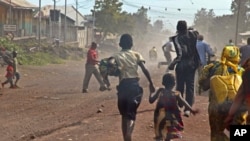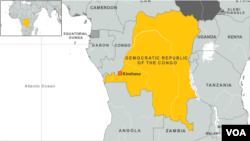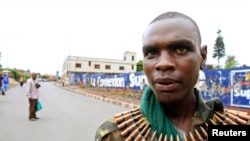KINSHASA, DRC —
The rebel group M23 has entered the city of Goma in eastern Democratic Republic of Congo, continuing their advance against government and United Nations troops. The rebels say they have taken the airport and witnesses say they are near the city center.
After days of fighting, M23 rebels have succeeded in their drive against the Congolese army and U.N. peacekeepers and advanced into the capital of North Kivu province.
While the exact situation in Goma is fluid, all accounts say that the rebels are gaining ground.
M23 making advances
Some residents and several journalists confirm M23’s claim to have taken the airport, on the eastern side of the town. Journalists say the rebels also have captured one of the two main border crossings from Goma to Rwanda, also on the eastern side of town.
Congo analyst Thierry Vircoulon of the International Crisis Group said the situation is taking a dire turn for the worse.
“My feeling is that the city is about to fall and we’ll know that during the course of the day, that’s for sure," said Vircoulon. "And there have been exchanges of fire between Rwanda and the DRC, which means we may not be very far from an open conflict between the two countries.”
U.N. radio in the DRC, Radio Okapi, reports that mortar rounds apparently fired from Rwanda killed four people Monday in Goma and wounded several others.
DRC government accuses Rwanda
Tuesday’s fighting comes after the government refused a rebel demand to negotiate, saying it would be pointless without involving Rwanda. The DRC accuses of Rwanda of providing arms and troops in support of M23 - allegations that Kigali continually has denied.
There are signs the escalating violence is causing problems for the Congolese government.
A leading opposition politician, Vital Kamehre - who came third in the presidential elections last year - has called on DRC President Joseph Kabila to negotiate with M23 to end the conflict and threats to the civilian population.
Opposition calls for negotiations
Up until now, the DRC’s opposition parties generally have agreed with the government’s position of rejecting talks with the rebels.
Goma was effectively controlled by a rebel movement until 2004, when the rebels were loosely integrated into the Congolese army. Most members of M32 are former soldiers who defected in April, claiming discrimination and poor treatment by the government.
The DRC and Rwanda have fought several wars - the last one during the Congolese civil war, which ended in 2003.
International concern is growing, with France preparing a draft resolution to slap sanctions on the rebels and possibly any elements supporting them. It could be adopted as early as this week.
After days of fighting, M23 rebels have succeeded in their drive against the Congolese army and U.N. peacekeepers and advanced into the capital of North Kivu province.
While the exact situation in Goma is fluid, all accounts say that the rebels are gaining ground.
M23 making advances
Some residents and several journalists confirm M23’s claim to have taken the airport, on the eastern side of the town. Journalists say the rebels also have captured one of the two main border crossings from Goma to Rwanda, also on the eastern side of town.
Congo analyst Thierry Vircoulon of the International Crisis Group said the situation is taking a dire turn for the worse.
“My feeling is that the city is about to fall and we’ll know that during the course of the day, that’s for sure," said Vircoulon. "And there have been exchanges of fire between Rwanda and the DRC, which means we may not be very far from an open conflict between the two countries.”
U.N. radio in the DRC, Radio Okapi, reports that mortar rounds apparently fired from Rwanda killed four people Monday in Goma and wounded several others.
DRC government accuses Rwanda
Tuesday’s fighting comes after the government refused a rebel demand to negotiate, saying it would be pointless without involving Rwanda. The DRC accuses of Rwanda of providing arms and troops in support of M23 - allegations that Kigali continually has denied.
DRC M23 Rebels Backgrounder
DRC M23 Rebels:- M23 fighters were once loyal to a rebel army that assimilated into the national army of Congo in a 2009 peace deal
- Hundreds of former rebel army members mutinied earlier this year, complaining that the government had not fulfilled promises of better pay and weapons
- From the mutineers, the M23 - named for the March 23, 2009 peace deal - emerged
- A U.N. report said there are indications the rebels are getting outside aid. U.N. experts say Rwanda and Uganda are backing M23. Both Countries deny this
- The U.N. Security Council is considering sanctions on M23 leaders and has demanded an end to "all outside support" of the group
- Experts say a driving force behind the regional conflict are deposits of tin, gold, tungsten, and coltan, a mineral used in laptops and mobile phones in eastern Congo, where M23 operates
A leading opposition politician, Vital Kamehre - who came third in the presidential elections last year - has called on DRC President Joseph Kabila to negotiate with M23 to end the conflict and threats to the civilian population.
Opposition calls for negotiations
Up until now, the DRC’s opposition parties generally have agreed with the government’s position of rejecting talks with the rebels.
Goma was effectively controlled by a rebel movement until 2004, when the rebels were loosely integrated into the Congolese army. Most members of M32 are former soldiers who defected in April, claiming discrimination and poor treatment by the government.
The DRC and Rwanda have fought several wars - the last one during the Congolese civil war, which ended in 2003.
International concern is growing, with France preparing a draft resolution to slap sanctions on the rebels and possibly any elements supporting them. It could be adopted as early as this week.









